Turn Out the Back Foot Funny
German Shepherds are a dog breed that is often mentioned when it comes to mobility issues especially in their older years. Mobility is an important consideration when it comes to taking care of your dog. Not only does it affect most of the normal daily activities that the dog is able to perform, but mobility issues can affect the dog's mood, appetite, and quality of life. Therefore, in this article, we explore some of the common German Shepherd back leg problems.
What are some common problems with the German Shepherd's back legs?
Some common problems with German Shepherd's back legs include degenerative myelopathy, hip dysplasia, and osteoarthritis. You can deal with these issues by observing a proper balanced diet, regular exercising appropriate to your dog, and massage to relieve fatigue and pain.
What makes German Shepherds' back legs particularly susceptible to these diseases?
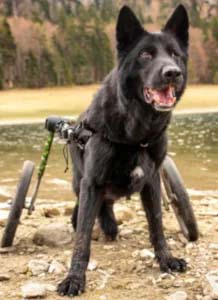
German shepherds' hind legs appear more bent as compared to a typical dog. In fact, German Shepherds are intentionally bred to have a steeper angulation to the hind legs. The AKC breed standards for the breed, require German Shepherds to have as close to 90 degree bend as possible in their hind leg. Unfortunately, this steep angle in the back leg makes German Shepherds more susceptible to back pain and hind leg problems. Due to the steeper angle of the leg, a German Shepherd's knee is closer to the ground which can change their gait. After years of wear and tear this makes them prone to serious leg problems as they age.
For instance, studies have shown that German Shepherds are five more times likely to develop dysplasia as compared to Labradors, Rottweilers, and Golden Retrievers.
A brief overview of these medical conditions:
Degenerative Myelopathy
Degenerative myelopathy (DM) is a neurological disease that makes german shepherds slowly lose control of their hind legs. In the end, the dog may lose control of the urinary and bowel functions and paralysis is a serious possibility. DM typically occurs in older dogs of about 8 years or older, although it may also occur at a younger age.
Unfortunately, there is no cure for DM. However, there are ways to reduce the suffering of your GSD because the condition progresses gradually. Therefore, treatment options for DM are geared towards ensuring a better quality of life rather than curing it. Most dogs with degenerative myelopathy will lose function of their hind legs within 6 months to two years of diagnosis. Although there is no cure, regular exercise has been show to improve the quality of life for dogs with DM.
Hip Dysplasia
Hip dysplasia is a disease that makes the ball of the German Shepherd's back legs do not fit properly into their sockets. The ball of the hip joint causes pain as it glides roughly against the socket. Signs of hip dysplasia include a wobbly gait, lameness, limping, a decreased range of motion, and pain while walking.
The most common causes of hip dysplasia include genetics, trauma to the legs, and environmental factors. Treatment options are given depending on the age of the dog and the misalignment of the hip joint. In extreme cases of hip dysplasia the dog may lose function of their hind legs and require a wheelchair.
Osteoarthritis
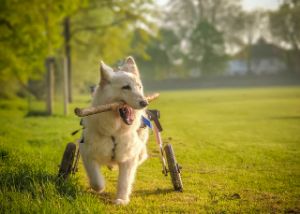
Osteoarthritis is a progressive disease that occurs when the cartilage of the dog's joints begins to degenerate in its older age. Arthritis may also occur due to the pressure exerted on the hip joint by hip dysplasia. Since GSD are prone to hind leg weakness they are at an increased risk for severe arthritis. Dogs with bad hips and arthritic joints may change their gait and walk lower to the ground, causing German Shepherd legs to appear even more bent.
Signs of osteoarthritis include lethargy, loss of muscle mass in the hind limbs, reluctance to run, jump, or go up a flight of stairs, and stiffness in the hind legs.
Prevention of osteoarthritis through proper dieting, exercising, and joint supplements helps to reduce the onset of osteoarthritis. Once osteoarthritis begins, the treatment is geared towards pain reduction, reducing inflammation, and improving the quality of life.
Since osteoarthritis is difficult to detect in symptoms until the affected joints are badly affected, it is crucial to keep up with regular wellness visits in your vet.

Walkin' Lift Rear Combo Harness
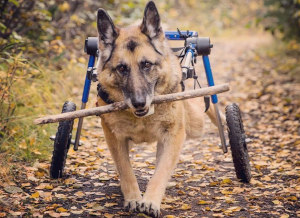
Walkin' Wheels Dog Wheelchair
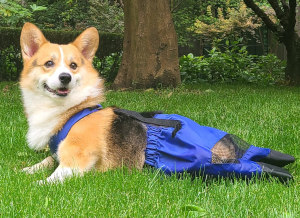
Walkin' Drag Bag
Enabling better health of your German Shepherd's back legs
Proper breeding
Many German Shepherd mobility problems are hereditary. The best way to prevent these diseases is through genetic testing and by following good breeding standards. This is possible by checking with your breeder for the hip score (with regards to hip dysplasia) and proper parent matching to avoid degenerative myelopathy.
Diet
It works wonders for humans, and it will work for your best friend too.
Since this breed is already a large-sized breed and the effects of breeding may be unpredictable, maintaining an optimal weight and observing a healthy balanced diet is a wise precautionary measure.
Some of the important dietary options to provide include ample proteins, vitamin D, vitamin K and magnesium, vitamin C, and vitamin E. You should also ensure that the dog food you buy for your German Shepherd is well suited, with enough calcium and phosphorus for healthy bone development.
Consult your vet on the proper portioning of these nutrients because they may change from time to time depending on your dog's age, weight, and health. Your vet may also prescribe bone and joint supplements such as glucosamine, chondroitin, and collagen if they are required.
Dealing with medical conditions affecting a dog's back legs
First, in DM, it is important to maintain an optimal weight for your German Shepherd. An obese or overweight will experience increased mobility challenges. Second, regular exercising especially walking and swimming is important. Swimming may be more up the German Shepherd's alley because it does not have to exert weight on the body but still gets in some aerobic movements in the hind legs. Lastly, consult your vet on supplements or medications that may slow down the progression of DM.
In any case, for these medical conditions, keep an eye out for changes in movement and contact your vet if there are any concerns. Some common symptoms that your German Shepherd may show include a wobbly walk, slipping on the floor, sitting crooked, hips giving way, swelling, lesser muscle mass in the back legs, and having a shorter stride on the hind legs.
Keep in mind that most dogs will not express pain or discomfort at first, so it is up to you to be keen to spot the symptoms if they do appear – this is especially important for the degenerative conditions because for treatment purposes, the earlier the better!
Regular exercising
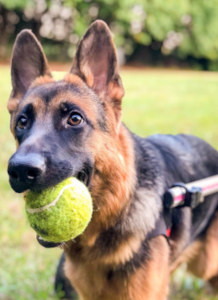
Regular exercising does two important things for your German Shepherd. One, it strengthens the hind and front leg muscles and two, it helps you to spot changes in the performance of the hind legs.
There are many routines out there for you to explore, but I'll mention one that applies specifically to the hind legs. This is the sit-to-stand routine.
In this routine, you start with your dog sitting in front of you. Then, you move back a bit and call the dog to you. When he follows, give a treat (to keep his interest) and once again, sit him down. Repeat as many times as needed.
The sit-to-stand routine is simple enough, but it does help to strengthen your dog's quads and hamstrings of the back legs.
Taking your dog on daily walks (up and down a hill especially) or having swimming sessions will also strengthen the leg muscles and help in managing the weight. Hydrotherapy is especially beneficial for dogs dealing with mobility issues.
Massage
Massaging is a good way to help your German Shepherd's hind legs particularly after an exercise session. Canine massage relieves fatigue and tension in the hind leg muscles and helps to spot any unrelated pain that may be a sign of something to watch out for.
How to massage your dog:
- Using both your palms and finger, compress the muscle against the bone with your flat hand.
- Glide your hand along his spine following the lay of the fur.
- Apply semi-circular strokes on the muscular areas of the back legs.
Using a support harness
Sometimes, it is crucial to moderate the pressure that your shepherd applies to the back legs when he moves about. This is where the support harness comes in. A harness helps to remove some of the stress that the dog may be feeling when taking walks, for instance, until the muscles of the back legs are strong enough to take it. Use of the harness reduces pressure placed on the bad back legs and makes it easier for your dog to walk.
Final Thoughts
When it comes to taking care of your German Shepherd's health, just like with any pet, being keen on his condition and staying on top of the preventative good practices for his overall health is important. Keep them at a healthy weight and ensure they get plenty of exercise. Even if your GSD is battling a degenerative illness affecting his mobility, you can explore treatment and supportive methods that will enable a good quality of life.
German shepherds are known as a very resilient and strong breed. Your dog will match and appreciate any effort you put in ensuring his good quality of life.
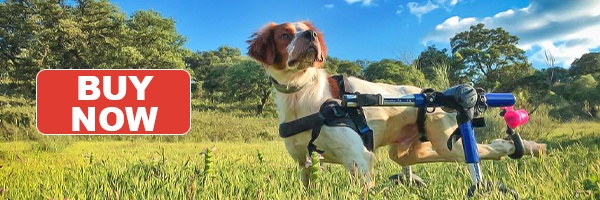 hbspt.cta.load(7685956, 'd8f40fad-471d-4892-bd27-ce0b5c27febb', {"region":"na1″});
hbspt.cta.load(7685956, 'd8f40fad-471d-4892-bd27-ce0b5c27febb', {"region":"na1″});
Source: https://www.handicappedpets.com/blog/german-shepherd-back-legs/
0 Response to "Turn Out the Back Foot Funny"
Post a Comment